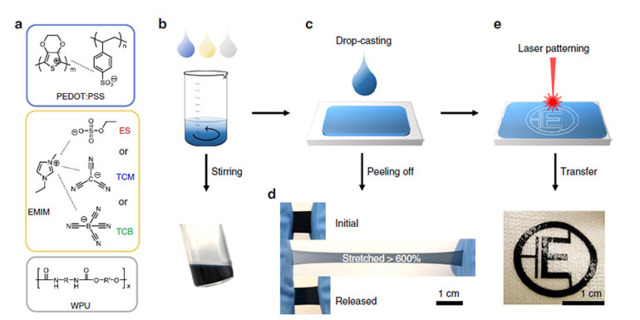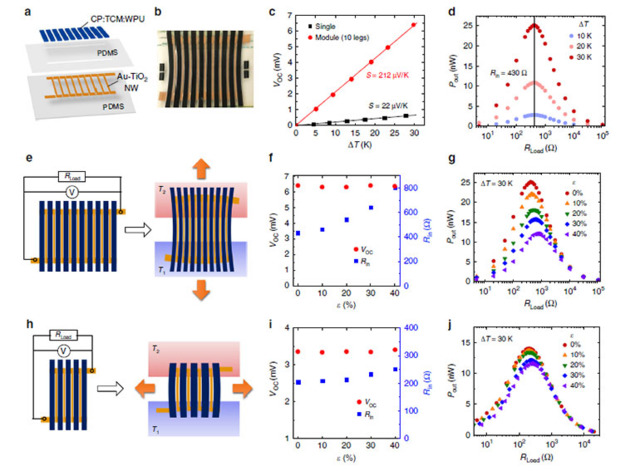this article regarded in digital Design and has been posted here with permission.
Thermoelectric generators (TEGs) and TE modules are eye-catching abilities sources of harvested power, but the stiffness of obtainable module materials makes them awkward and unsortable for "personal" on-epidermis use, despite the supply of the warmth supply (dermis). To counter this challenge, a school-based crew has created what they declare is the primary intrinsically stretchable, organic, thermoelectric module that's gentle and stretchable, making it an excellent fit for wearable purposes comparable to dermis patches.
The multidisciplinary team became led by means of researchers at the Laboratory of organic Electronics at linköping college (Sweden), with help from researchers in Belgium, New Zealand and California. They mixed three substances: the conducting polymer PEDOT:PSS (a really common polymer used in lots of applications as a result of its good thermoelectric homes, however too tough and brittle for wearable electronics); a water-soluble polyurethane rubber; and an ionic liquid.
The outcome is a composite with wonderful residences, with cloth bringing alluring qualities to the composite. The PEDOT:PSS offers it thermoelectric houses, the rubber provides elasticity, and the ionic liquid ensures softness.
despite the fact, combining them, whereas not adversely affecting their alluring properties, turned into an immense problem (Fig. 1). "Our material is a hundred times softer and 100 times greater stretchable than PEDOT:PSS," said Klas Tybrandt, who leads the community of sentimental Electronics on the Laboratory of biological Electronics.

1. Printable elastic conducting polymer composites: Chemical buildings (a) of PEDOT:PSS (conducting polymer (CP), water-borne polyurethane (WPU) and various kinds of ionic beverages (ILs), of which aqueous dispersions/answer can be mixed in one pot to formulate the composite ink (b). The solution processability of the composite ink (c) permits for drop-casting to supply thick films (>forty µm). A free-standing composite movie can also be stretched to over 600% and calm down to its fashioned shape with little hysteresis (d). A laser-patterned composite film can also be transferred and adhere to irregular surfaces like textiles (e). (supply: hyperlinköping college/Sweden)
introduced assignment leader Nara Kim, "The composite changed into formulated through water-based answer mixing and it will also be printed onto a considerable number of surfaces. When the floor flexes or folds, the composite follows the movement. And the manner to manufacture the composite is low-cost and environmentally pleasant." the ensuing material has sophisticated efficiency within the three correct-tier areas of interest because it combines excessive conductivity (>a hundred and forty S/cm) with superior stretchability (>600%), elasticity, and low younger's modulus (<7 MPa).
As a TE material, electrical efficiency is a vital consideration, of direction (Fig. 2). A module became fabricated through laser-slicing the drop-forged composite film into 10 legs of uniform thickness and transferring them onto a substrate. The legs were then connected in collection by a sample of gold-covered titanium-dioxide nanowires embedded within the substrate.

2. Intrinsically stretchable organic thermoelectric module: (a) An structure of the stretchable thermoelectric (TE) module. One end of each and every TE leg is electrically interconnected with the different end of a neighboring leg through a z-shape stretchable interconnect. (b) picture of a stretchable TE module below 30% tensile pressure. (c) Open-circuit voltage (VOC) of a single-leg TE device and a 10-leg TE module as a characteristic of temperature change (ΔT). d) Output power (Pout = Vout2/Rload) of a TE module as a feature of load resistance (Rload) for ΔT = 10-30 ok. The dashed line indicates a Rload price that offers the maximum Pout, and thereby corresponds to the whole interior resistance (Rin) of a module. (e-g) TE module stretched parallel with the thermodiffusion; T1 = 23 °C, T2 = 53 °C; f) VOC; and Rin vs. tensile strain (ε) applied to a module for ΔT = 30 ok. (g) Pout vs. Rload beneath distinct strains for ΔT = 30 k. (h-j) TE module stretched perpendicular to the thermodiffusion and corresponding VOC and Rin vs. ε and Pout vs. Rload under different strains for ΔT = 30 k. (source: linköping school/Sweden)
among the measured outcomes, with a temperature change (ΔT) of up to 30 okay applied to the two edges of the p-classification 10-legs module, the open-circuit voltage (VOC) generated is linearly proportional to ΔT, leading to a VOC/ΔT ≈ 212 μV/okay—here is near 10 instances the Seebeck coefficient of S ≈ 22 μV/ok measured for a single TE leg.
When the module is linked to varying load resistors (Rload) beneath ΔT = 10 to 30 k, the Pout reaches its optimum for Rload ≈ 430 Ω, which corresponds to the whole Rin of the module. The optimum Pout below ΔT = 30 okay is 25 nW, which is close to the anticipated cost, Pout-max = VOC2/4Rin ≈ 24 nW. Tensile loading up to forty% in each parallel and perpendicular directions didn't affect the VOC of the stretchable module. although, the Rin increases progressively with expanding strain as a result of the stress-elegant resistances of the composite legs and the interconnects.
details of the challenge are posted in Nature Communications, "Elastic conducting polymer composites in thermoelectric modules," along with considerable extra particulars in the posted Supplementary counsel.
No comments:
Post a Comment